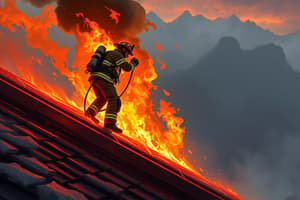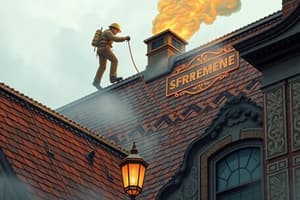Podcast
Questions and Answers
What is one of the initial duties of the company reporting to the roof?
What is one of the initial duties of the company reporting to the roof?
- Create a water supply plan.
- Determine the color of the building.
- Assess the number of firefighters on scene.
- Report the type of roof and conditions present. (correct)
Which of the following is NOT an objective for roof operations?
Which of the following is NOT an objective for roof operations?
- Complete adequate size ventilation holes.
- Provide progress reports to Command.
- Coordinate roof ventilation with interior crews.
- Perform landscape management around the fire scene. (correct)
What should be included in the follow-up roof report after completing a vertical ventilation assignment?
What should be included in the follow-up roof report after completing a vertical ventilation assignment?
- Previous fire reports of the same location.
- The stability of the roof and effects of ventilation. (correct)
- The conditions of the roof's electrical system.
- The historical background of the building.
Why is it important to provide progress reports to Command during roof operations?
Why is it important to provide progress reports to Command during roof operations?
What factor determines whether the roof is safe for operation?
What factor determines whether the roof is safe for operation?
What is one of the primary objectives of roof operations during a fire emergency?
What is one of the primary objectives of roof operations during a fire emergency?
Which condition should be reported concerning the roof to Incident Command?
Which condition should be reported concerning the roof to Incident Command?
What should the follow-up roof report primarily focus on?
What should the follow-up roof report primarily focus on?
What information about ventilation should be confirmed by the initial company on the roof?
What information about ventilation should be confirmed by the initial company on the roof?
What is essential for coordinating roof ventilation with interior crews?
What is essential for coordinating roof ventilation with interior crews?
During roof operation, who is responsible for monitoring roof structure and fire conditions?
During roof operation, who is responsible for monitoring roof structure and fire conditions?
Which aspect should NOT be included in the initial report to Incident Command?
Which aspect should NOT be included in the initial report to Incident Command?
What does the term 'production' refer to in the context of a follow-up roof report?
What does the term 'production' refer to in the context of a follow-up roof report?
What is a recommended action after confirming the roof's stability?
What is a recommended action after confirming the roof's stability?
Flashcards are hidden until you start studying
Study Notes
Roof Supervisor Responsibilities
-
The initial company on the roof is responsible for reporting key information to Incident Command
-
- This crucial information encompasses various aspects of the roof structure, such as the type of roofing material used, which may affect the fire behavior and response strategies. It should also include the observation of any visible smoke or flames emanating from ventilation points, as this may indicate fire presence inside the building. Additionally, any loads present on the roof, including HVAC equipment or other ventilators, must be noted, as they can impact the roof's structural integrity under emergency conditions. Roof stability is critical; thus, it is important to assess any signs of weakening. The presence of fire extension on adjacent facades or neighboring structures requires careful examination. Details about the firewall configuration, attic conditions that may contribute to fire spread, and the complexity of the building's footprint, should also be documented, along with any firefighting actions that have already been undertaken.
Roof Operations Objectives
-
Establishing a safe working surface on the roof
-
Creating adequately sized ventilation holes to achieve effective ventilation
-
Coordinating ventilation activities with interior fire crews
-
Coordinating fire control operations on the roof as instructed by the incident commander
-
Monitoring the roof structure and fire conditions continuously
-
Providing regular reports on progress to Incident Command
Follow-Up Report
- A follow-up report is required after completing ventilation activities
- This report should detail the impact of ventilation (volume and intensity of smoke, fire, or heat escaping from the vent hole), attic conditions, roof stability, and subsequent actions planned for the team.
Roof Division or Ventilation Group Supervisor Duties
- The first company to reach the roof must report these details to Incident Command:
- The type of roof
- What is visible (fire/smoke) from (roof vents, updraft ventilators, turbine vents, skylights, scuttles, facade vents, etc.)?
- Loads (HVAC and ventilators)?
- Condition of the roof (stable or unstable) deformity or discoloration?
- Fire extension to the facade and/or adjacent occupancies?
- Confirmation of firewall(s) and location?
- Conditions in the attic (if known)?
- Basic blueprint/footprint of the building if unusual.
- Actions taken.
Roof Operations Objectives
- Determine a safe working surface.
- Create adequately sized ventilation holes and achieve effective ventilation.
- Coordinate roof ventilation with interior crews.
- Coordinate roof fire control operations as directed by Command.
- Monitor the roof structure and fire conditions from the roof.
- Provide progress reports to Command.
Follow-Up Roof Report
- A follow-up roof report should be given after personnel have completed vertical ventilation.
- The report should include:
- The effect of the vertical ventilation (the amount and intensity of smoke/fire/heat coming from the vent hole, AKA “production”).
- Conditions in the attic.
- The stability of the roof.
- Your next actions.
Studying That Suits You
Use AI to generate personalized quizzes and flashcards to suit your learning preferences.




